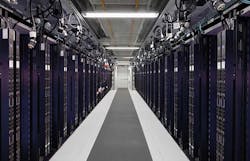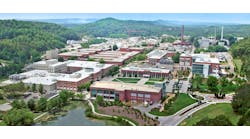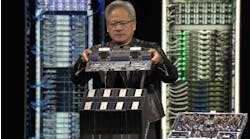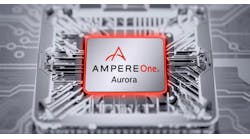DCX Launches, Targeting High-Density Colocation for AI Workloads
DCX is a new brand in the data center industry, targeting cutting-edge requirements for high-density computing. But the founding team behind DCX is among the most experienced in the digital infrastructure sector.
DCX is led by George Slessman, who is again teaming with his brother Bill to create a data center business. The Slessman brothers have been pioneers in data center design and operations for more than two decades in their careers at IO Data Centers, Baselayer and the Downtown Phoenix Technology Exchange.
Their next venture comes out of stealth mode today with DCX Goodyear 1, a new facility in the Greater Phoenix market that will host applications for artificial intelligence (AI) and machine learning (ML).
“We’re focused on a niche market in mission-critical computing,” said George Slessman, the CEO of DCX. “These are data suites designed for ultra-high-density computing. We’ve engineered a unique data center service at DCX that meets our target users’ needs today and into the future.”
Goodyear 1 is situated in Goodyear, a sub-market of Phoenix that is home to a growing cluster of data centers, including a new Microsoft cloud region.
DCX is operating on a six-acre campus, with two suites online supporting up to six megawatts of power. The site can quickly expand to 12 megawatts and six private data suites. Each data suite offers from 700 kW to 1 megawatt of capacity and features dedicated critical infrastructure, including UPS and generators, and waterless cooling systems.
The first customer is already installed and operating in a modular data center designed by HP. The Slessmans were pioneers in modular data center design at IO, designing and building pre-fabricated, factory-built IT enclosures. DCX will offer clients the option of a modular design or a traditional data hall.
‘Built for the Next Generation of Infrastructure’
DCX will be among a small number of infrastructure providers focused on colocation for high-performance computing (HPC), which has historically been hosted at private universities or facilities operated by the U.S. Department of Energy. More enterprises are seeking to harness AI to make their devices and services smarter, and adopting powerful hardware that runs hotter than traditional CPU-driven servers.
“This is built for the next generation of infrastructure,” said George Slessman. “We’ve heard from researchers and other high-performance users. This is the data center colocation service they’ve always needed. DCX lets our clients focus on what they want and need to focus on: their research and results.
“We engineered out the risk and uncertainty,” Slessman said. “We protect important research from the risks found in most large-scale colocation facilities, where everything – including power, cooling and connectivity – is an interconnected and interdependent risk.”
Data center modules in the first phase of DCX Goodyear 1, a new project from DCX. (Image: DCX)
DCX will offer a range of support options, including a fully-managed solution that can operate on a “lights-out” basis, he said. “The end user doesn’t even have to visit the data center if they don’t want to. The remote management tools are so good now.”
Infrastructure operations will be overseen by TBL Mission Critical LLC, where Managing Partner Samir Shah is also an alum of IO and BaseLayer.
Looking Beyond the Hyperscale Sector
DCX is charting a different course than many new entrants in the data center sector, who typically have either bought or built platforms seeking to support hyperscale users like Meta, Google, Microsoft or Amazon Web Services.
“The data center segment has gotten very, very large,” said George Slessman. “Everyone is so focused on the hyperscale users, and it’s really left behind the customer base we’ve built for in the past. They use public cloud for some things, but for other workloads they want dedicated infrastructure. On fringe uses like HPC, there’s no distinct advantage to going to the cloud.”
Likely customer sets include:
- College and university research teams.
- Private-sector research teams in healthcare, pharmaceuticals, sciences and
technology. - Advanced HPC and AI/ML projects in large enterprises and government agencies.
While these applications may not run on the cloud, they often seek to be cloud-adjacent. DCX plans to expand into other regions of the U.S., including the Midwest and East Coast. In each case, the DCX infrastructure will seek proximity to large cloud campuses, providing fast direct connections from high-density data-crunching apps at DCX to commodity resources on cloud platforms.
‘Built for the Next Generation of Infrastructure’
In the Western U.S., the right location was Goodyear, which is about 20 miles west of Downtown Phoenix. Microsoft has acquired 420 acres of land in Goodyear to support two data centers, and Amazon Web Services has also bought land in town. At least four other data center developers have projects underway in Goodyear.
“We are thrilled to have such an important resource right here in our community,” said Goodyear Mayor Joe Pizzillo. “Goodyear and our region have become a hub for technology and research, and DCX is a great addition to Goodyear’s thriving technology sector. We’re pleased to welcome such a fine provider of these services.”
The Slessmans’ first data center venture was the Downtown Phoenix Technology Exchange, the original “carrier hotel” interconnection facility in the Phoenix market. The brothers teamed with executive Tony Wanger and private equity firm Sterling Partners in developing the business, which was acquired by Digital Realty in 2006 for $175 million.
In 2007, the Slessmans again teamed with Wanger to create IO Data Centers, which became an early mover in building massive data centers, as well as advancing modular data center design. In 2014, IO spun off Baselayer to handle development of its data center modules and management software. After building a global network, IO was acquired by Iron Mountain in 2017 for $1.3 billion.
The Slessmans are now back in the data center sector with DCX, which will part of a larger platform of AI-focused technology businesses.
“We look forward to evolving with AI/ML high-performance computing data center requirements to make DCX the premier provider to users and the important work they do,” said George Slessman. “There’s a bit of a mission in this for me. I genuinely believe that the United States needs to invest more in its high-performance computing capability. This type of capacity just doesn’t sprout out of the ground magically when you need it. I would love to look back in 10 years and see that we deployed hundreds of petaflops of capacity used by U.S. researchers to advance important work. These are things that matter.”






